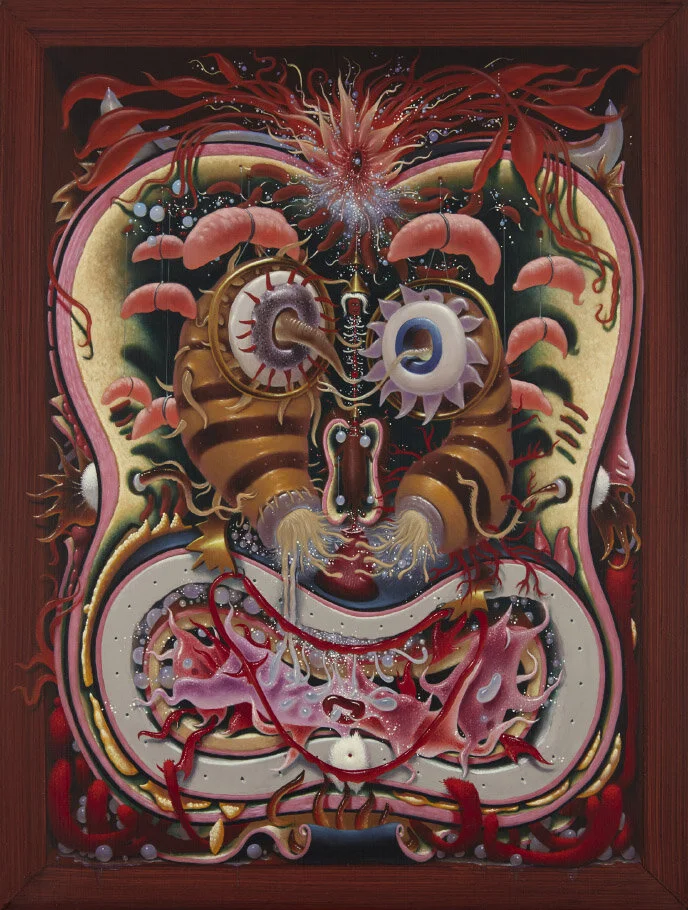Lou Fauroux
I first encountered Lou Fauroux’s works as a video installation envisioning a world where death was dead. A detritus-meets-Windows installation turned the space into the pre-apocalyptic future projected in the artist’s film, where hackers were plotting to subvert this inclusive iteration of In Time (ICYMI: the trailer is enough). Scattered across the floor and walls were memorabilia as obsolete as CD-roms and exhibition texts. Some called her work post-internet while others called it hyperpop, easily conflating her art and music practices as she had recently co-founded the label FÆRIES RECORDS. That was a year ago.
Fauroux, born in 1998, recently opened her first commercial solo at Exo Exo, a project-space-turned-gallery in the Haut-Marais. The green lights have now faded features music-filled sculptures as well as a 30-minute 3D video piece. Departing from a speculative future where Zuck and Elon have won (too soon/too close), the show operates as a shelter from both personal grief and queer isolation.
In the main room, there are six sculptures which seem to be components of a castigated vehicle. Five of them are attached to headphones which loop songs from an EP Fauroux has yet to publish. The sound relies heavily on distorted pop synths and oversaturated tunes, issuing a strange sense of almost familiarity.
The video, To whom it may concern, there will be tears in my Hennessy, carries the namesake of a poem written by Fauroux’s recently deceased sister. It is a journey across 3D patchwork landscapes, floating in space as utopias or memories. There’s a countryside house with Furbies and dragons floating around, an abandoned church where a child’s drawing appears on the back of a stone, an assembly of tombs moving in a mechanical choreography. The air is dense, filled with a perceptible melancholy and a feeling of safety; filled with idiosyncratic symbols that could either be nonsensical associations or hallmark emblems of a Y2K adolescence; filled with a bootleg auto-tuned remix of The Fray’s How to Save a Life and French cloud rap trailblazers PNL’s A l’Ammoniaque. The amount of personal and cultural references overwhelming the 30-minute long video triggers both contemplation and hyperattention.
Coined by N. Katherine Hayles in 2007, hyperattention refers to the fragmented, multitasking cognitive mode that is notably fostered by digital hypertextuality, as opposed to deep attention. The original concept is presented with unambiguously negative overtones: younger generations, inundated with screens from an early age, would lack the capacity to focus on complex, longer, tasks. However, such a one-sided critique — which would fuel right-winged policies across Europe such as the cellphone age bans currently being debated in the UK and France — clearly fails to acknowledge the fact that attention might not only be a resource, but a social construct. In her recent essay Disordered Attention: How We Look at Art and Performance Today, Claire Bishop denounces the way this approach “obviates the idea that other forms of attention are equally valid, and potentially more resistant, vital, creative, and fulfilling”. Fluid navigation between cognitive modes, as well as between digital and IRL, might be the experience of part of Fauroux’s generation of artists, and a tool to weave across her practice. Furthermore, if the normalised standard of attention would be an essential device for reproducing beings with cognitive ability to thrive under and reinforce hegemonic power, hyperattention could even be understood as a model and tool of queer survival. What does this mean for hyperpop?
The term has been widely overused in trendy circles in Paris, used to denote anything remotely post-internet. Julie Ackermann, who just published the eponymous book Hyperpop, goes deeper into the relevant function of the genre: “it talks about pop, and it does pop without taking apart its expressive and emotional power.” The strongest links between Fauroux’s show and the genre may not be its appearance as it may seem upon first glance, but by its way of operating. The multiple and visual references populating her pieces are not intended to serve as a post-ironic mashup of overwhelming information; their density reflects a personal collection of meaning to the artist, preserving the raw emotion of pop. At some point in the video, the saturated voice of Isaac Slade screeches “And I would have stayed up with you all night” — and it nearly leaves me in tears.
Fauroux’s use of toys, songs and symbols that populated her childhood is not only an altar meant for remembrance but also a tool for coping — shared means of coping in the face of unbearable conditions by populating a space with shared references and emotions. “Hyperpop,” Julie Ackermann continues, “is not about mere nostalgia: it is aimed at all of those who were teenagers in the 2000s and were exposed to conservative cultural productions, helping them reappropriating spaces they priorly excluded from.” The green lights have now faded transfigures the individual experience of pain and grief into a protective collective space.
A hyper-shelter ?
words by SAMUEL MARIN BELFOND
What to read next


















